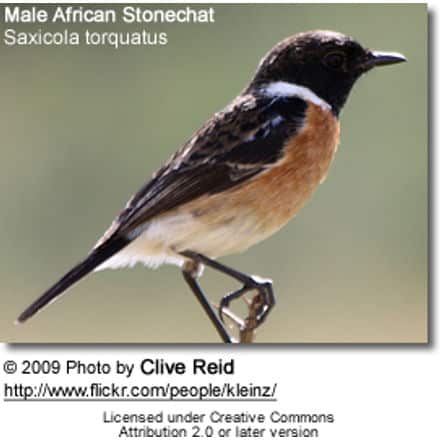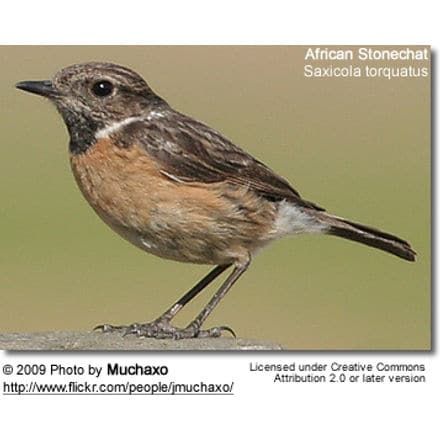African Stonechats
The African Stonechats (Saxicola torquatus) is a species of the Old World flycatcher family (Muscicapidae), inhabiting sub-Saharan Africa and adjacent regions.
Like the other chats, it was long assigned to the thrush family (Turdidae), to which the chats are convergent. Its scientific name refers to its appearance and habitat and means “collared rock-dweller”: Saxicola from Latin saxum (“rock”) + incola (“one who dwells in a place”), torquatus, Latin for “collared”.
In the past S. torquatus usually referred to the entire “Common Stonechat” superspecies and some sources still keep it that way, but all available evidence strongly supports full species status for the European (S. rubicola) and the Siberian Stonechat (S. maurus) of temperate Eurasia, in addition to the island-endemics Fuerteventura Chat (S. dacotiae) and Réunion Stonechat (S. tectes) which were never unequivocally accepted into S. torquata. Also, the well-marked populations of the Horn of Africa uplands (and Arabia?) and Madagascar (and Grande Comore?) may well qualify as yet additional species.
Description and distribution
The African Stonechats male has a black head, a white half-collar, a black back, a white rump, and a black tail; the wings are black with a large white patch on the top side of the inner wing. The upper breast is usually dark orange-red, with a sharp or gradual transition to white or pale orange on the lower breast and belly depending on the subspecies. In a few, black replaces the orange breast feathers in part or entirely.
Females have brown rather than black above and on the head with an indistinct paler eyebrow line, chestnut-buff rather than orange below, and less white on the wings. Both sexes’ plumage is somewhat duller and streakier outside the breeding season.
It has a scattered distribution across much of sub-Saharan Africa, occurring locally as far north as Senegal and Ethiopia. Outlying populations are found the mountains of southwest Arabia and on Madagascar and Grande Comore. It is non-migratory, moving only locally if at all. As a result, it has developed much regional variation, being divided into about 15 subspecies.
Systematics and taxonomy
The closest relative of African Stonechats is apparently not the Eurasian population but the Réunion Stonechat (S. tectes), but still, the “white-collared” Saxicola form a distinct group in the genus. S. torquatus and S. tectes form a sub-Saharan African lineage that diverged from the Eurasian one in the Late Pliocene, roughly 2.5 million years ago. Réunion was colonized shortly thereafter, indicating a rapid expansion along the Indian Ocean coast of Africa. With the Sahara drying out in the subsequent Quaternary glaciation, the African and Eurasian populations became isolated for good.
The recent separation as species was proposed after mtDNA cytochrome b sequence and nDNA microsatellite fingerprinting analysis of specimens of the subspecies Saxicola torquatus axillaris but not S. t. torquatus, and hence this species was briefly known as S. axillaris.
Subspecies
The subspecies differ slightly in size, and more in the extent of the orange-red on the upper breast of the males, and whether the lower breast is white with a distinct boundary from the upper breast, or pale orange with an indistinct boundary from the darker upper breast. The extent of the orange-red also varies with time of year, often extending on to the belly outside the breeding season.
- Saxicola torquatus torquatus (Linnaeus, 1766) – E South Africa
- Saxicola (torquatus) sibilla (Linnaeus, 1766), Madagascar Stonechat – Madagascar
- Saxicola (torquatus) albofasciatus (Rüppell, 1845), Ethiopian Stonechat – Ethiopian highlands
Upper breast black, not orange-red.
- Saxicola torquatus salax (J. and E.Verreaux, 1851) – N Angola, W Democratic Republic of the Congo (formerly Zaire), Congo, Gabon
- Saxicola torquatus axillaris (Shelley, 1884) – Kenya, Uganda, NW Tanzania, Rwanda, Burundi, E Democratic Republic of the Congo (formerly Zaire)
- Saxicola torquatus pallidigula (Reichenow, 1892) – High altitudes on Mount Cameroon, Cameroon
The largest subspecies. Length of flattened wing c.75-78 mm (3 in).
- Saxicola torquatus jebelmarrae Lynes, 1920 – Darfur (Sudan)
- Saxicola torquatus adamauae Grote, 1922[ – Cameroon
Mid-sized, length of flattened wing c.70 mm (c.2.7 in).
- Saxicola torquatus promiscuus Hartert, 1922 – Western Mozambique, eastern Zambia, central Tanzania
Very limited orange-red on uppermost part of breast only.
- Saxicola torquatus voeltzkowi Grote, 1926 – Grande Comore
- Saxicola torquatus nebularum Bates, 1930 – Tropical West Africa from Sierra Leone to Côte d’Ivoire
Extensive orange-red on breast and also flanks.
- Saxicola torquatus moptanus Bates, 1932 – Scattered in the W Sahel from N Senegal to Niger
The smallest subspecies.
- Saxicola torquatus felix Bates, 1936 – SW Saudi Arabia and W Yemen
- Saxicola torquatus oreobates Clancey, 1956 – High altitudes in the Drakensberg and other mountains of Lesotho and immediately adjacent South Africa
- Saxicola torquatus stonei Bowen, 1932 – C southern Africa, from northernmost South Africa north to Democratic Republic of the Congo (formerly Zaire) and southwestern Tanzania
- Saxicola torquatus clanceyi Latimer, 1961 – W South Africa
- Saxicola torquatus altivagus Clancey, 1988 – E Zimbabwe, Mozambique, Malawi
Previously included within promiscua, and very similar to it.





